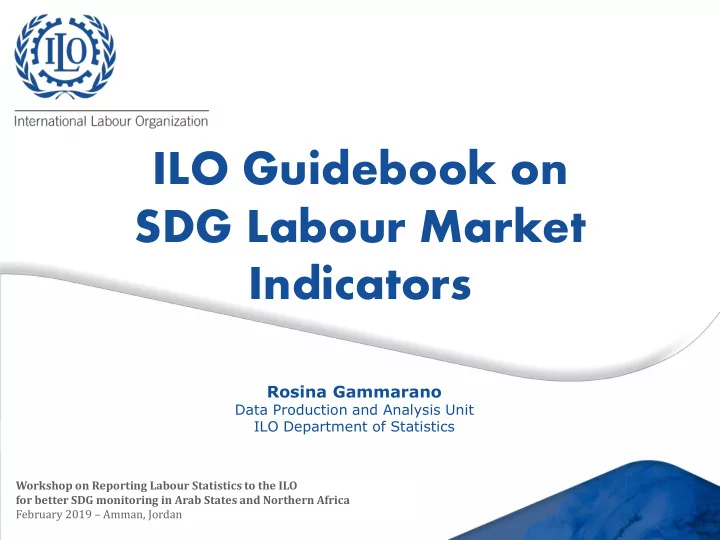

ILO Guidebook on SDG Labour Market Indicators Rosina Gammarano Data Production and Analysis Unit ILO Department of Statistics Workshop on Reporting Labour Statistics to the ILO for better SDG monitoring in Arab States and Northern Africa February 2019 – Amman, Jordan
2 ILO Department of Statistics
Why was a Guidebook on SDG Labour Market Indicators necessary? 3 ILO Department of Statistics
Monitoring is crucial to achieve the SDGs: Global Monitoring Framework at the core of the SDGs Agenda Need for one resource with all the relevant information about all the SDG labour market indicators Need for information about sources and methods, data availability, interpretation and limitations of SDG labour market indicators 4 ILO Department of Statistics
What does the Guidebook include? 5 ILO Department of Statistics
Role of SDG Tier custodian classification Indicators Information on agencies Concepts For Tier I and II Calculation and SDG Labour Market definitions Indicators Data Interpretation Visualization sources Limitations and use and analysis (national and international) For Tier III Brief SDG Labour Market description Indicators 6 ILO Department of Statistics
Example: I keep hearing about the youth NEET rate – what is that? 7 ILO Department of Statistics
SDG Indicator 8.6.1 – The youth NEET rate DEFINITION & CONCEPTS Proportion of youth not in education, employment or training: Employed Youth In education or training Not in education Outside the or training Youth labour force NEET Unemployed 8 ILO Department of Statistics
SDG Indicator 8.6.1 – The youth NEET rate DEFINITION & CONCEPTS ● Youth: ages 15-24 inclusive ● Employment: work for pay or profit for use by others ● Education: organized and sustained communication designed to bring about learning. Includes formal and non-formal education but excludes informal education. ● Training: non-academic learning activity to acquire specific skills intended for vocational or technical jobs. 9 ILO Department of Statistics
SDG Indicator 8.6.1 – The youth NEET rate CALCULATION Youth NEET rate = 𝑍𝑝𝑣𝑢ℎ – 𝑍𝑝𝑣𝑢ℎ 𝑗𝑜 𝑓𝑛𝑞𝑚𝑝𝑧𝑛𝑓𝑜𝑢 – 𝑍𝑝𝑣𝑢ℎ 𝑜𝑝𝑢 𝑗𝑜 𝑓𝑛𝑞𝑚𝑝𝑧𝑛𝑓𝑜𝑢 𝑐𝑣𝑢 𝑗𝑜 𝐹𝑒 𝑝𝑠 𝑈𝑠 x 100 𝑍𝑝𝑣𝑢ℎ 𝑞𝑝𝑞𝑣𝑚𝑏𝑢𝑗𝑝𝑜 Which can also be expressed as: Youth NEET rate = (𝑉𝑜𝑓𝑛𝑞𝑚𝑝𝑧𝑓𝑒 𝑧𝑝𝑣𝑢ℎ + 𝑍𝑝𝑣𝑢ℎ 𝑃𝑀𝐺)–(𝑉𝑜𝑓 𝑧𝑝𝑣𝑢ℎ 𝑗𝑜 𝐹𝑒 𝑝𝑠 𝑈𝑠+ 𝑍𝑝𝑣𝑢ℎ 𝑃𝑀𝐺 𝑗𝑜 𝐹𝑒 𝑝𝑠 𝑈𝑠) x 100 𝑍𝑝𝑣𝑢ℎ 𝑞𝑝𝑞𝑣𝑚𝑏𝑢𝑗𝑝𝑜 10 ILO Department of Statistics
SDG Indicator 8.6.1 – The youth NEET rate DESIRED DISAGGREGATIONS ● No disaggregations specifically required ● Strongly advisable to have data at least by sex ● Overarching principle of data disaggregation of the SDG Global Indicator Framework: SDG indicators should be disaggregated, where relevant, by income, sex, age, race, ethnicity, migratory status, disability and geographical location. 11 ILO Department of Statistics
SDG Indicator 8.6.1 – The youth NEET rate DATA SOURCES Information needed on: ● Age ● Labour market situation (employed or not) ● Education and training participation / enrolment Labour force surveys preferred source Data available in ILOSTAT for over 140 countries 12 ILO Department of Statistics
SDG Indicator 8.6.1 – The youth NEET rate INTERPRETATION & USE Measure of youth labour underutilization o Broader than youth unemployment o Broader than youth inactivity o Captures also the fact of not developing skills and qualifications (not in Ed or Tr) Complementary measures: youth LFPR, youth UR NEET composed of two subgroups (unemployed and outside the labour force): -> important for interpretation 13 ILO Department of Statistics
SDG Indicator 8.6.1 – The youth NEET rate LIMITATIONS ● Comparability issues linked to operational criteria used, sources, definitions, etc. ● Youth refers to ages 15-24 but it may be relevant to study share of persons NEET in other age groups ● Youth NEET rate gives no information on its composition – prevalence of each subgroup (unemployed and outside the labour force) 14 ILO Department of Statistics
SDG Indicator 8.6.1 – The youth NEET rate VISUALIZATION & ANALYSIS Youth NEET rate, 60% TTO male and female IND 50% IRN SLV TZA 40% LKA PSE Source: ILOSTAT. EGY ARM TUR ZAF MEX Three-digit ISO Female DZA ALB IDN QAT COL 30% KGZ country codes are PHL PAN REU DOM PER BIH SAU VEN BRA used to identify MDA CRI MKD ECU URY countries. ROU ITA UKR PRY 20% BGR SRB GTM THA USA GRC CHL ISR SGP MYS CMR HRV MLI ABW ESP CYP RUS SVK BLR IRL NZL EST HUN MOZ GBR PRT BEL LVA AUS FRA MLT POL KHM BLZ 10% CZE CAN FIN LTU SVN UGA MNE AUT DEU HKG CHE SWE DNK LUX BMU MAC BEN JPN NLD NOR FLK ISL MNG 0% 0% 10% 20% 30% 40% 50% 60% 15 Male ILO Department of Statistics
What are the next steps? 16 ILO Department of Statistics
SDG Global Monitoring Framework updated continuosly: tier reclassification → New edition of the Guidebook soon (to reflect methodologies adopted at the #ICLS20) ILO Guidebook on SDG Labour Market Indicators is a great tool, but not enough → Complemented by our other capacity building activities Related analytical products (forthcoming) → WESO (2019), HLPF 2019 reports (further analysis of trends and progress towards achieving SDGs) 17 ILO Department of Statistics
Thank you 18 ILO Department of Statistics
Recommend
More recommend